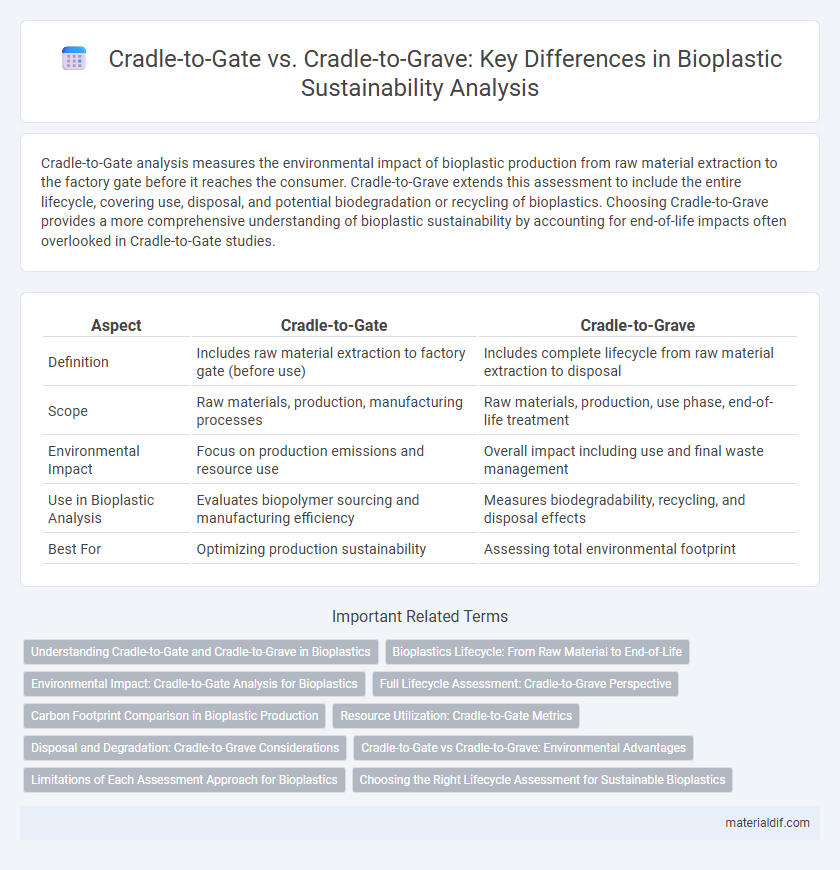Cradle-to-Gate analysis measures the environmental impact of bioplastic production from raw material extraction to the factory gate before it reaches the consumer. Cradle-to-Grave extends this assessment to include the entire lifecycle, covering use, disposal, and potential biodegradation or recycling of bioplastics. Choosing Cradle-to-Grave provides a more comprehensive understanding of bioplastic sustainability by accounting for end-of-life impacts often overlooked in Cradle-to-Gate studies.
Table of Comparison
| Aspect | Cradle-to-Gate | Cradle-to-Grave |
|---|---|---|
| Definition | Includes raw material extraction to factory gate (before use) | Includes complete lifecycle from raw material extraction to disposal |
| Scope | Raw materials, production, manufacturing processes | Raw materials, production, use phase, end-of-life treatment |
| Environmental Impact | Focus on production emissions and resource use | Overall impact including use and final waste management |
| Use in Bioplastic Analysis | Evaluates biopolymer sourcing and manufacturing efficiency | Measures biodegradability, recycling, and disposal effects |
| Best For | Optimizing production sustainability | Assessing total environmental footprint |
Understanding Cradle-to-Gate and Cradle-to-Grave in Bioplastics
Cradle-to-Gate evaluates the environmental impact of bioplastics from raw material extraction to the factory gate, excluding product use and disposal phases, emphasizing sustainable production processes. Cradle-to-Grave extends the assessment to include product use, disposal, or recycling, providing a comprehensive lifecycle analysis crucial for understanding bioplastics' end-of-life environmental effects. Comparing these approaches highlights key stages for reducing carbon footprint and improving biodegradability in bioplastic manufacturing and waste management.
Bioplastics Lifecycle: From Raw Material to End-of-Life
The bioplastics lifecycle spans from raw material extraction to end-of-life, with cradle-to-gate assessing environmental impacts up to product manufacturing, while cradle-to-grave evaluates the full spectrum including use and disposal phases. Cradle-to-gate analysis emphasizes feedstock cultivation and biopolymer production, revealing crucial carbon sequestration and reduced fossil fuel dependency benefits. Cradle-to-grave extends this view by incorporating biodegradability and compostability metrics, highlighting bioplastics' potential in minimizing landfill accumulation and promoting circular economy goals.
Environmental Impact: Cradle-to-Gate Analysis for Bioplastics
Cradle-to-Gate analysis evaluates the environmental impact of bioplastics from raw material extraction to factory exit, highlighting reduced greenhouse gas emissions and lower fossil fuel dependence compared to conventional plastics. This approach quantifies resource usage, energy consumption, and pollutant output during bioplastic production stages, providing a clearer sustainability profile. In contrast to Cradle-to-Grave, which includes use and disposal phases, Cradle-to-Gate concentrates on upstream impacts, aiding manufacturers in optimizing eco-friendly processes.
Full Lifecycle Assessment: Cradle-to-Grave Perspective
Cradle-to-Grave assessment evaluates the entire lifecycle of bioplastics from raw material extraction, production, and use, to disposal or recycling, providing a comprehensive understanding of environmental impacts. This full lifecycle assessment includes energy consumption, greenhouse gas emissions, and end-of-life scenarios such as biodegradability or landfill persistence. Compared to Cradle-to-Gate, which stops at the factory gate, the Cradle-to-Grave perspective enables more accurate sustainability analysis and better informs circular economy strategies for bioplastics.
Carbon Footprint Comparison in Bioplastic Production
Cradle-to-Gate assessments of bioplastic production measure the carbon footprint from raw material extraction through manufacturing, excluding use and disposal phases, resulting in lower reported emissions compared to Cradle-to-Grave evaluations. Cradle-to-Grave analyses include the entire product lifecycle, capturing carbon emissions during production, use, and end-of-life treatments such as biodegradation or recycling, providing a more comprehensive environmental impact. Studies show that while bioplastics have a reduced carbon footprint relative to conventional plastics in Cradle-to-Gate metrics, the total emissions in Cradle-to-Grave scenarios depend heavily on disposal methods and biodegradability characteristics.
Resource Utilization: Cradle-to-Gate Metrics
Cradle-to-Gate metrics in bioplastic analysis emphasize resource utilization from raw material extraction to manufacturing, excluding product use and disposal phases. This approach highlights inputs such as biomass feedstock consumption, water use, and energy efficiency during production. Focusing on these metrics enables assessment of environmental impacts and sustainability potential at the initial stages of the bioplastic life cycle.
Disposal and Degradation: Cradle-to-Grave Considerations
Cradle-to-grave assessment of bioplastics emphasizes the environmental impact during disposal and degradation phases, highlighting biodegradability and compostability as key factors. Unlike cradle-to-gate analysis, which only covers production to factory exit, cradle-to-grave includes end-of-life scenarios such as landfill, incineration, and industrial composting. Bioplastics designed for effective degradation contribute to reduced greenhouse gas emissions and lower persistent plastic waste in ecosystems.
Cradle-to-Gate vs Cradle-to-Grave: Environmental Advantages
Cradle-to-Gate assessments of bioplastics measure environmental impacts from raw material extraction to factory exit, highlighting reduced resource consumption and greenhouse gas emissions compared to conventional plastics. Cradle-to-Grave analyses extend this scope to include product use and end-of-life disposal, emphasizing bioplastics' biodegradability and lower pollution potential in landfills or composting environments. Evaluating both reveals that bioplastics offer significant environmental advantages by minimizing carbon footprint during production and enabling more sustainable waste management practices.
Limitations of Each Assessment Approach for Bioplastics
Cradle-to-Gate assessments for bioplastics often overlook end-of-life impacts such as biodegradation or recycling pathways, limiting the full environmental footprint analysis. Cradle-to-Grave approaches provide a comprehensive life cycle perspective but require extensive data on disposal, which can vary widely based on regional waste management practices. Both methods face challenges in accurately capturing bioplastic performance due to variability in feedstock sources, production processes, and degradation rates.
Choosing the Right Lifecycle Assessment for Sustainable Bioplastics
Cradle-to-Gate lifecycle assessment evaluates the environmental impact of bioplastics from raw material extraction to factory gate, providing detailed insights into production-phase sustainability. Cradle-to-Grave extends this analysis to include product use and disposal, offering a comprehensive view of the entire environmental footprint. Selecting the appropriate assessment depends on project goals, with Cradle-to-Gate suited for manufacturing optimization and Cradle-to-Grave essential for full sustainability evaluation in bioplastic lifecycle management.
Cradle-to-Gate vs Cradle-to-Grave Infographic

 materialdif.com
materialdif.com